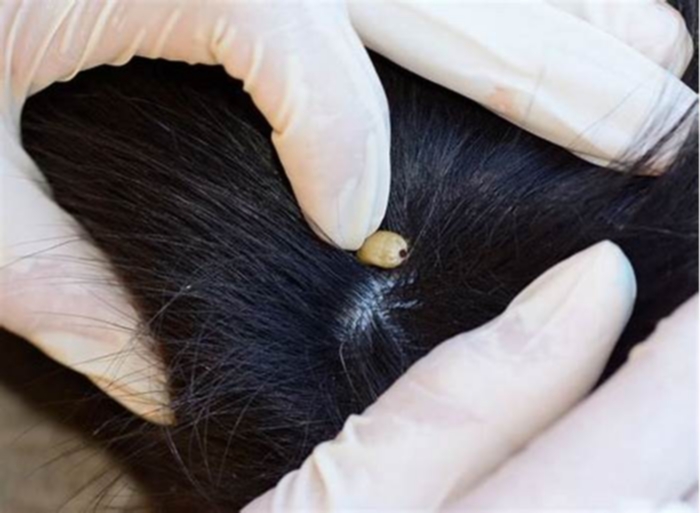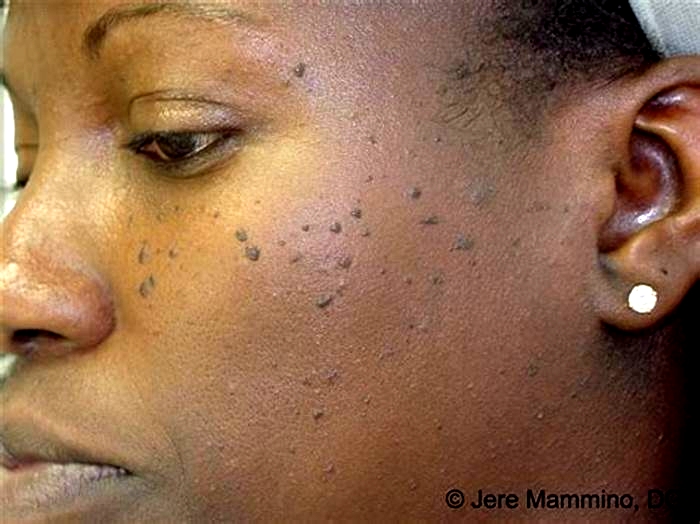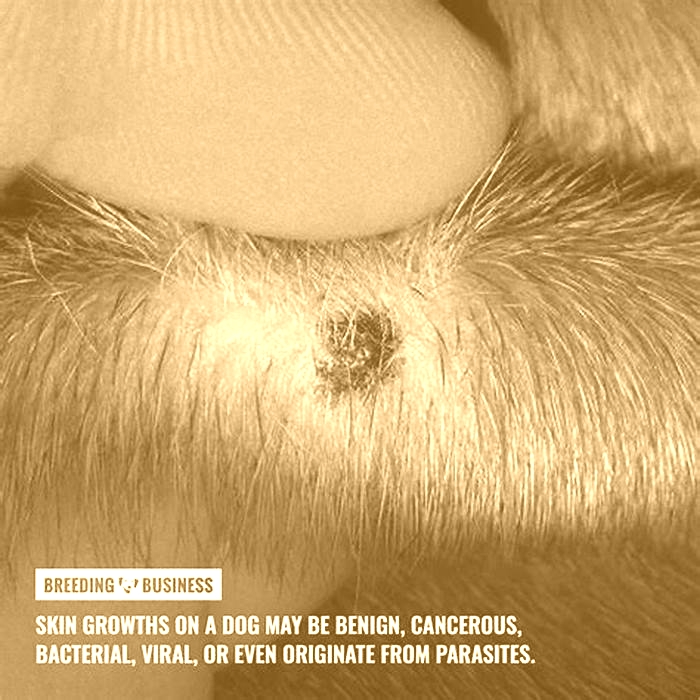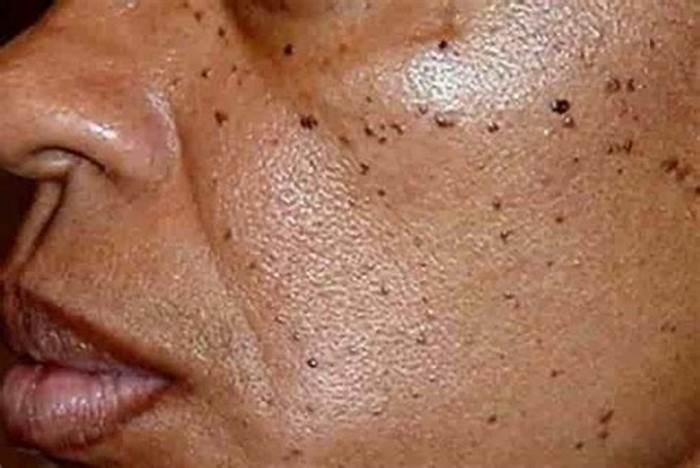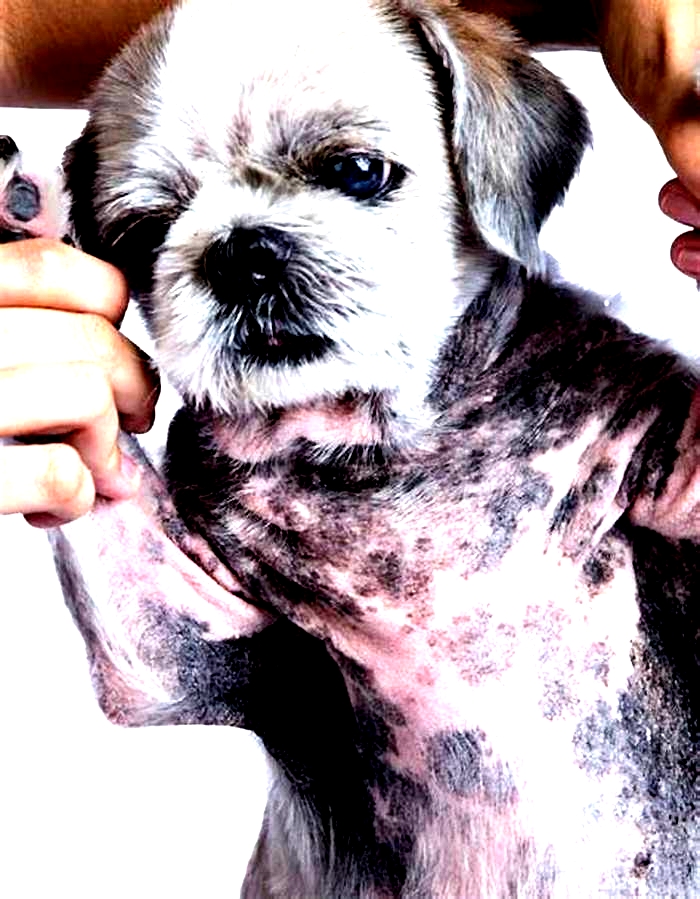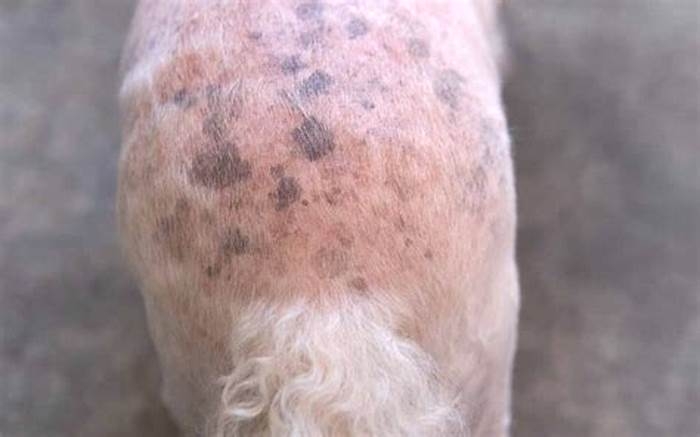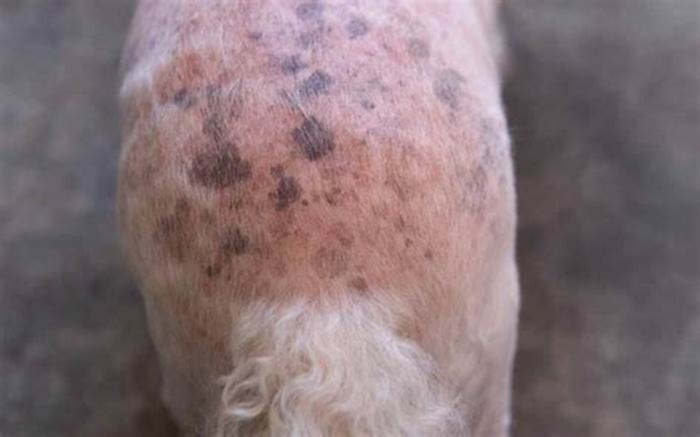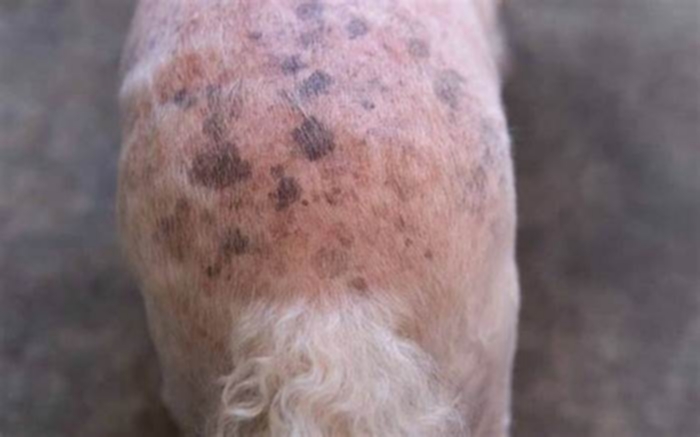What is the black parasite on my dog s skin
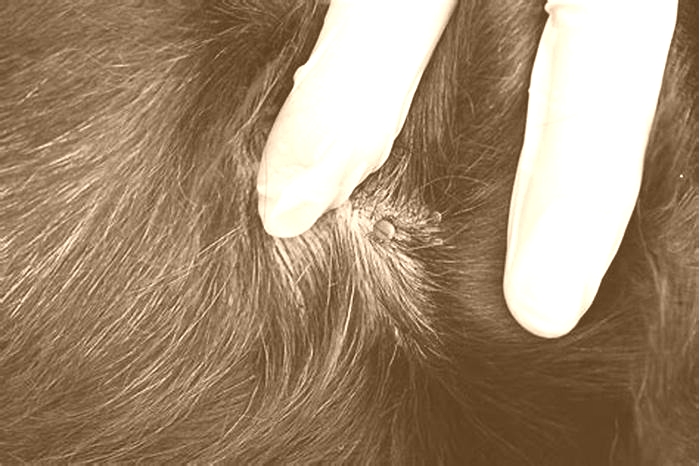
Common Skin Parasites in Dogs
Fleas are Common Skin Parasites in Dogs
If you share your life and home with dogs, one of the most common problems that you have to deal with is combatting fleas and protecting your pet from flea infestation. These tiny, pesky insects can be found just about anywhere. They are blood-sucking parasites and are important causes of flea allergy dermatitis (FAD). The saliva of fleas contains a protein that hypersensitive dogs can be allergic to. These dogs can develop intense itching and scratching that can leave the skin raw which can predispose to the development of hot spots.
Fleas feed on the blood of their hosts and heavy infestations in young puppies or senior pets can lead to the loss of a significant amount of blood, resulting in anemia. Fleas are also important carriers of tapeworms.
Flea treatment must be done throughout the year and is not just a one-time deal. Flea eggs can be found in every nook and cranny of your home. And even if your pet does not have any trace of fleas, these eggs will hatch when the conditions are right and are important sources of reinfection. Thus, you should work closely with your vet in creating a preventive health program for your pet that will include regular prevention against fleas. This can help ensure that your pet has adequate protection against flea bites not only during flea season but through all the months of the year.
Flea treatment can be given topically or orally. Heavy infestations require a thorough cleaning of your home and yard. In some cases, there may be a need for a professional pest exterminator to get rid of the fleas.
Your Dog Should be Protected from Ticks
Ticks, like fleas, are blood-sucking parasites. Theyre also important carriers of zoonotic diseases, such as Lyme disease and Rocky Mountain Spotted Fever, which can be transmitted to humans. Dogs get ticks when they roam and romp in wooded areas. Ticks also abound in brush and shrubs. Theyre quick to hitch a ride on passing dogs, and even humans. Thats why its very important to check your pet for ticks after every outdoor excursion. Ticks are commonly found on the dogs neck, ears, between the toes, and between the legs and body. However, they can be found just about anywhere on your pets body. Heavy tick infestations can cause skin irritation and anemia. These parasites can also cause an illness called tick paralysis.
Ticks on your pets body should be removed immediately once you spot them. This can diminish the chance of disease transmission. Any disease they may be carrying can be transmitted when ticks feed. Proper tick removal is also important. There is the risk of the ticks head or mouthparts being left embedded in the dogs skin if you just pull and twist on the tick to remove it; this can cause a reaction that may develop into an infection. Another thing to remember when removing ticks - avoid crushing them. This may cause the tick to regurgitate saliva while still being embedded on your pets skin, and if the tick is infected, it could increase your pets risk of disease.
Depending on where you are living, tick prevention may be recommended year-round or during the tick season only. You should ask your vet for recommendations based on your region. However, the possibility of being infected by ticks at any time exists because their eggs can hatch when the conditions are right. If ticks are a problem in your area, you should work closely with your vet in creating a preventive health program to protect your dog from ticks throughout the year.
Ear Mites Are Also Common Skin Parasites in Dogs
Ear mite infestations in dogs are very itchy and uncomfortable, which can cause excessive head shaking and ear scratching. The mites are microscopic, and your pet can pick them up from being in contact with another pet thats infested or from the surroundings.
Excessive scratching can cause irritation and bleeding sores in and around the dogs ears. Blood vessels in the ear flap may also break when the dog keeps on shaking his head causing the formation of an aural hematoma which is a pocket of blood in the ear flap.
Another common symptom with ear mite infestations is a brown or black ear discharge. There may also be a foul odor from the dogs ears that indicates secondary infections caused by yeast or bacteria.
The presence of ear mites is confirmed by examining a sample of the ear discharge under a microscope. If your pets symptoms are confirmed to be a result of ear mite infestation, the treatment regimen usually involves ear cleaning and medication that will be prescribed by your vet.
Mange Mites in Dogs
Mange is caused by parasitic mites that burrow into the skin. The most common types of mange in dogs are sarcoptic mange and demodectic mange.
Sarcoptic Mange Mites (Canine Scabies)
Sarcoptic mange (also called scabies) is caused by microscopic mites that belong to the Sarcoptes species. Dogs of any age and size can be hosts of the sarcoptic mange mites. Infestations are highly contagious and can easily be spread from one dog to the next by close contact with infested animals, or from contaminated bedding, grooming tools, or carpets. Humans can also get canine scabies from their dogs.
Intense itching is a prominent symptom of sarcoptic mange. It is associated with the burrowing of the mites on the uppermost layer of the dogs skin. Excessive scratching can lead to skin rashes and crusting as well as hair loss. Affected dogs are also more prone to developing secondary infections. The symptoms include intense and persistent itching, raw skin, sores, and patchy hair loss. The lesions are commonly found on the dogs face, ears, and legs.
People can also get a rash after being in close contact with a dog thats harboring the mites. The presence of Sarcoptes mites is confirmed by a microscopic exam of a skin scraping from an infected dog.
In addition to administering medication to kill the mites in infested dogs, the dogs environment should be cleaned and treated to get rid of the mites. Antihistamines and topical antibiotics may be necessary to alleviate inflammation and resolve secondary infections.
Demodectic Mange Mites (Demodex)
Mange caused by Demodex mites tends to affect puppies less than 6 months of age. Unlike sarcoptic mange, demodectic mange is not contagious. Puppies usually acquire the mites from a mother dog thats infested.
Demodectic mange lesions can be local or generalized. Local infestations are marked by scaly skin patches and redness around the puppys eyes and mouth. The symptoms may also develop on the legs and trunk. Generalized demodicosis is a more severe form of demodectic mange. Affected dogs have widespread hair loss, skin inflammation, and scaly, thickened skin. Secondary bacterial infections are a likely result of the skin lesions and will warrant additional treatment.
Demodectic mange may be present in dogs with an underlying health issue and whose immune system function has been compromised. Microscopic examination of skin scrapings taken from the dog can confirm the presence of Demodex mites.
Localized demodectic mange is generally easy to treat and has a favorable prognosis. On the other hand, treatment of generalized demodicosis is more challenging. Aggressive treatment may be necessary and may stretch for a considerable length of time.
Read more:
Parasites That Cause Diarrhea in Dogs
Common Intestinal Parasites in Cats
Ditch the Itch: Skin Allergies in Dogs
Need to speak with a veterinarian regarding skin parasites in dogs or another condition?
Click here to schedule a video consult to speak to one of our vets. You can also download the FirstVet app from the Apple App Store and Google Play Stores.
6 Types of Black Lumps on Dogs [With Pictures]
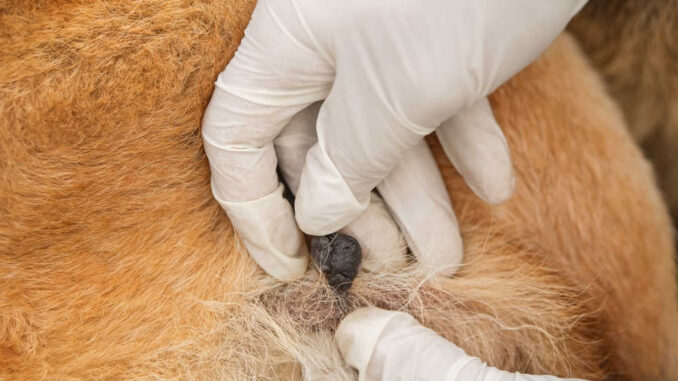
This article was updated on October 18th, 2023

It can be concerning to see a new black lump on your dog, particularly because black growths may mean cancer in human medicine. When I worked as a veterinarian, I encountered various causes for black bumps on dogs: some were cancerous, but others were benign and nothing to worry about. Lets look at the most common types with pictures selected by our veterinarians.
Black lumps, bumps, or growths on dogs
1. Warts or adenomas
Very common, mostly in senior dogsWarts, caused by canine papillomavirus, and adenomas are some of the most common types of small lumps on dogs. These masses are benign, irregularly shaped like cauliflower, and usually pale in appearance. Below are two examples of black warts. Notice the irregular, raised shapes:
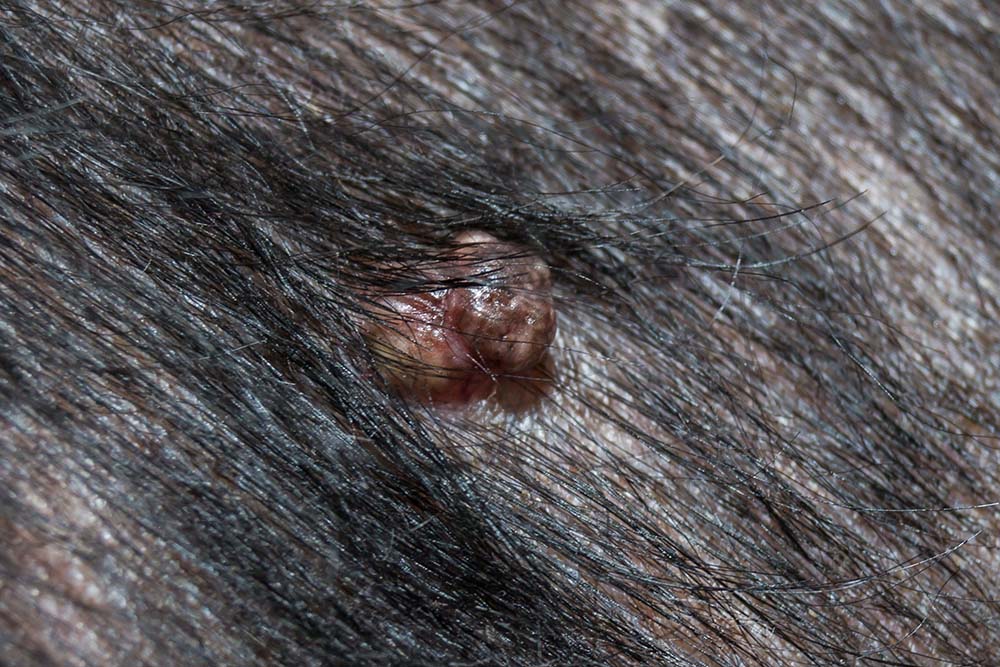
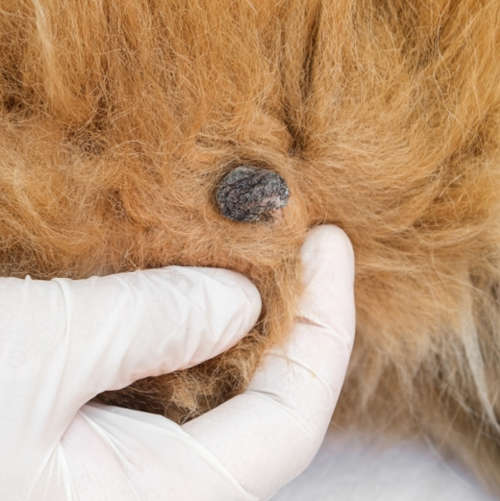
Although warts and adenomas are not a major concern, they can become infected or ulcerated. When warts become inflamed or infected, blood or pigment can turn the bumps dark. When warts become problematic, the treatment of choice is surgical removal. Learn more about Warts (Pictures & Treatments).
2. Skin tags
Very commonSkin tags are benign fibrous growths that usually occur in high-friction areas on your dogs skin. With a variable appearance, tags may look like raised bumps or attach to the body on a narrow stalk. They appear with or without hair. Skin tags are very common in dogs and can sometimes be black.
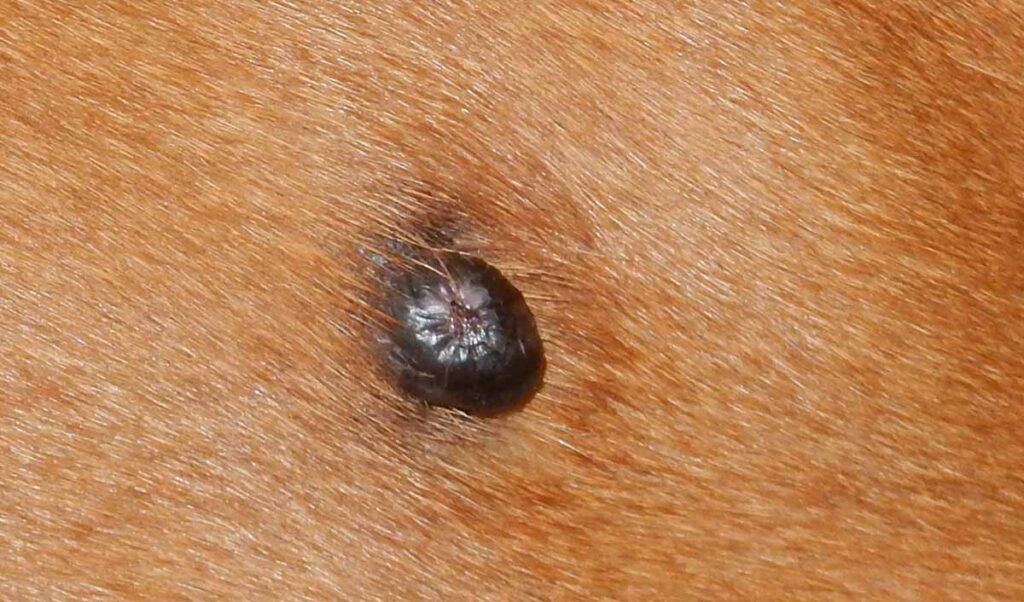
You may suddenly see a new skin tag on your dog, but they usually take time to develop. They are generally harmless but can become irritated and painful from constant rubbing. As long as your dog isnt bothered, skin tags can be left alone. You should also contact your veterinarian if you notice any changes in color, shape, or size. Learn more about Skin Tags: Pictures, Diagnosis, Treatment.
3. Histiocytomas turning black over time
Very common, mostly in younger dogs (up to 3 years old)Histiocytomas are benign, dome-shaped lumps that arise when immune cells (histiocytes) overgrow. They suddenly appear on the face, ear flaps, or legs, can grow rapidly, and may ulcerate. Although histiocytomas are normally red/pink in color, they can turn black over time, as shown on the picture below:
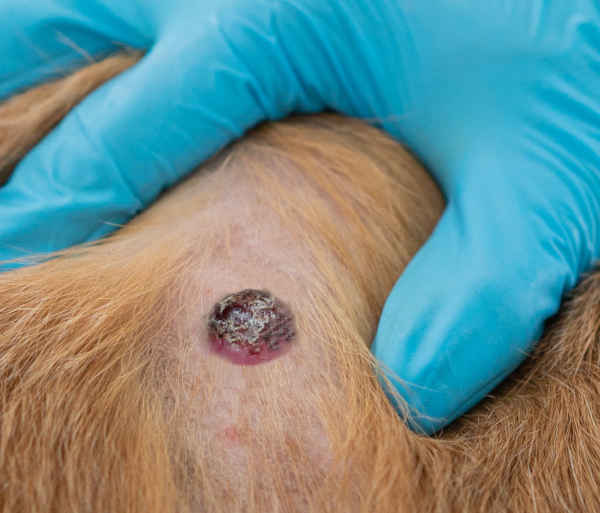
If you have a young dog that develops a histiocytoma, discourage him from licking, chewing, or scratching the bump. This will help to prevent inflammation, infection, and ulceration.
Most histiocytomas will resolve spontaneously in 1-3 months without treatment. Learn more about Histiocytomas.
4. Cancerous tumors: melanomas
Melanomas are malignant growths that appear as black or dark lumps, often found in older dogs on their lips or mouth (as shown on the images below). When pigment-producing cells known as melanocytes grow proliferatively, they usually create brown or black lumps because the cells contain melanin granules.
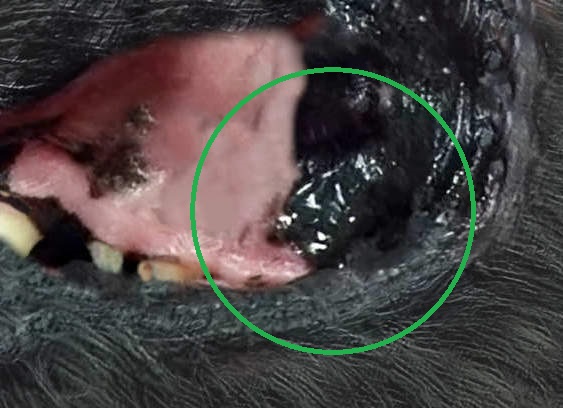
These tumors often grow rapidly and spread quickly to other parts of the body.
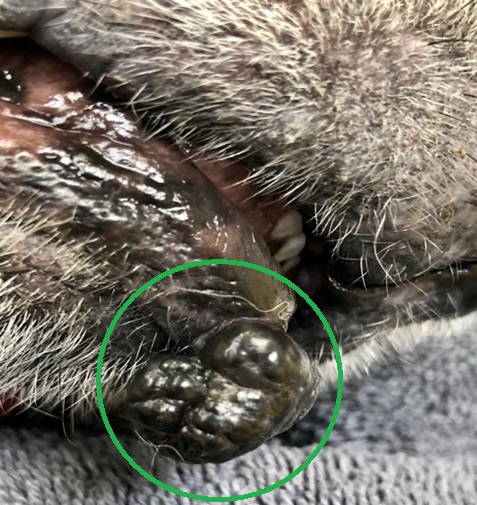
Black or dark cancerous lumps:
Cancerous lumps tend to grow quickly and in an unpredictable manner, which often results in an irregular shape. This is illustrated by the black lumps in the two pictures below:
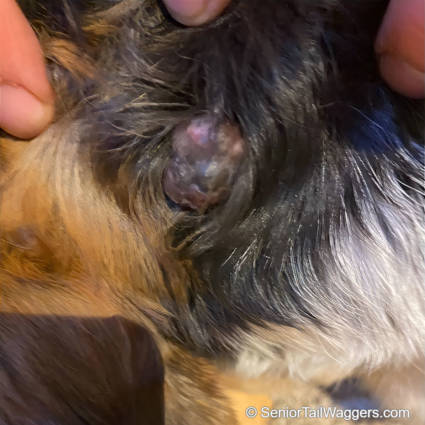
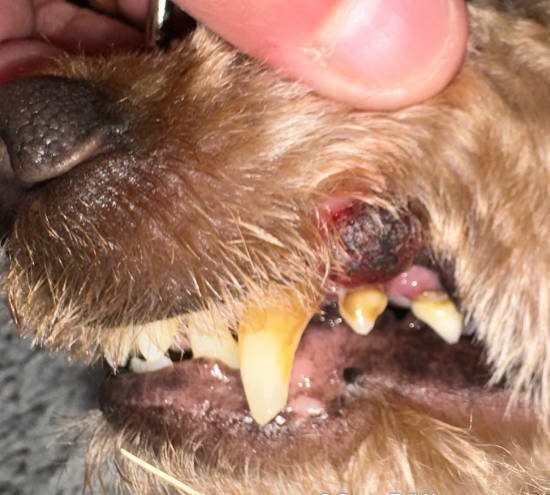
Early diagnosis and treatment are important because they significantly impact your dogs diagnosis. The primary method to treat melanomas is the surgical removal of the tumor along with surrounding tissues that may be affected. Learn more about Melanomas (Pictures & Treatments).
If a lump or lesion appears red, black, or generally unhealthy in appearance, it may be more likely to be malignant. Cancerous lesions and lumps are also often harder and firmer to the touch.However, keep in mind that it is generally not possible to tell if a lump is cancerous or not just by looking at it: a biopsy is generally needed (more information regarding this is provided later in this article).
5. Darker ticks
Some embedded ticks can mimic black bumps when you see them on your dogs skin. Depending on where you live, some common ticks on dogs include deer ticks, American dog ticks, and Lone Star ticks. If you find an embedded tick on your dog, you may remove it at home or have your veterinarian extract the parasite.
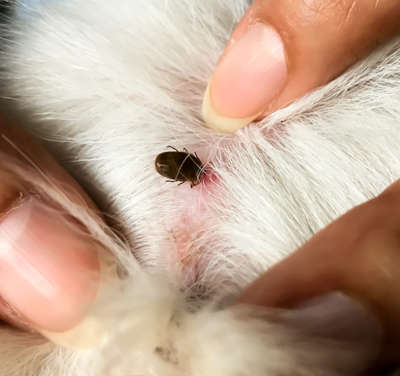
To remove a tick, use fine-tipped tweezers and grasp the pest as close to your dogs skin as possible. Pull the tick straight out with gentle, steady pressure. Avoid twisting, as you may break off the head, which can cause infection. Once the tick is out, examine it to make sure you have the entire body, then disinfect/wash the bite area.
6. Hygromas
Hygromas typically form on the bony prominences of large dogs who lie on hard surfaces like pavement or tiles. They form in an effort to protect the dogs skeleton and to minimize friction. In the photo below, the dog has a hygroma on the elbow and the fur above it is missing; this would be quite typical:
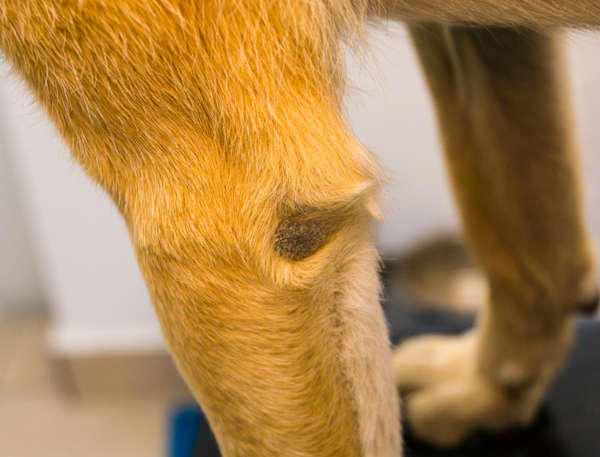
Hygromas
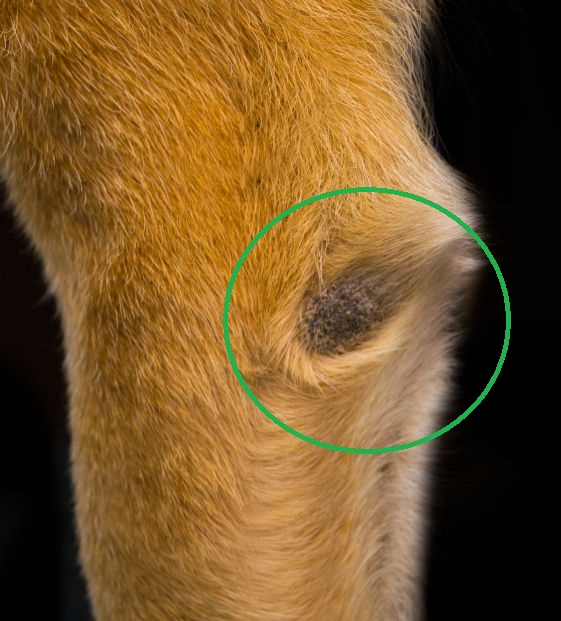
A biopsy is generally needed to confirm the nature of a lump
When owners bring their dogs to our clinic because of a black lump, we typically perform a physical examination and run tests that may include:
- evaluating the characteristics of the mass including size, shape, depth, and more
- taking a fine needle aspirate or biopsy and submitting it to the lab for analysis
- running bloodwork to check for endocrine disorders or signs of infection
- skin scrapings or hair samples if we suspect issues such as mites or skin infections
- impression smears to help diagnose the cause of scabs
Estimated cost of diagnosis
Depending on your dogs particular situation, your vet may want to charge the following:
- office visit and initial exam approximately $50-100
- bloodwork $150-300 in most cases
- aspirate, skin scrapings, or impression smears with cytology $25-250
- biopsy with pathology $300-600
- bacterial or fungal cultures $300-400
Why are some lumps black?
Bumps or growths on dogs can be black mostly because they are one of the following:
- blood-filled lumps: when a dogs skin experiences trauma, blood may collect at the point of injury. Over time, the blood dries and turns reddish-brown or black, like a scab.
- tumors: whether the growth is benign or malignant, it may collect pigment granules known as melanin that turn the bump black. They often appear in response to skin inflammation, but the cells that produce melanin sometimes turn cancerous, causing malignant black tumors (known as melanomas).
Top causes of black spots or scabs on the skin
Below, well look at various reasons that black spots, scabs, or raised, itchy patches of dark skin may suddenly appear on your dog.
1. Hyperpigmentation
When your dogs skin is traumatized, melanocytes produce extra pigmentation to protect the damaged areas resulting in black spots on your dogs skin. Common causes of hyperpigmentation include injuries, allergies, parasites, aging changes, cancer, or endocrine disorders like Cushings disease or hypothyroidism.
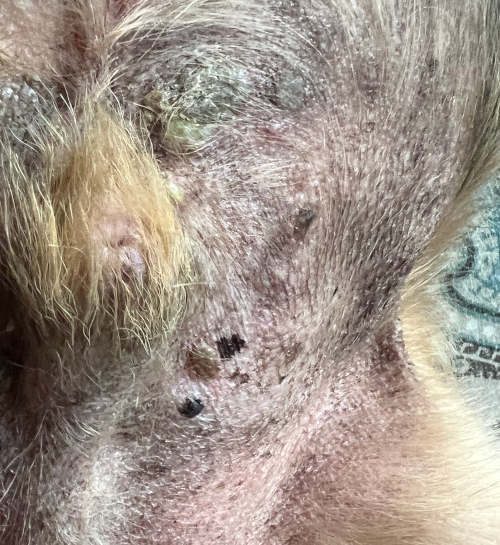
If your senior dog develops black patches or spots on his skin but there arent any other changes, its probably age spots. However, you should contact your veterinarian if there are other changes to the skin like:
- scaliness
- thickening
- roughening
- itchiness
- crustiness
- redness around the margins
These symptoms often indicate an underlying condition that requires treatment.
2. Injury
Injuries such as scrapes or cuts are the most common cause of black scabs in dogs. When the skin surface is traumatized, it seeps blood and platelets. A clot forms and dries to form a protective covering over the skin. Over time, the scab turns dark brown to black.
As long as the scab doesnt turn yellow or become infected, and your dog leaves it alone, you can let the skin heal naturally. If your furbaby continually licks and abrades the area, you may need to use an E-collar to protect the wound from further irritation.
3. Allergies
When your dog reacts to a food-based or environmental allergen, he can develop an allergy skin rash or hives. At first, the skin will be red and irritated, but if the inflammation is chronic, the area may become thickened, darkly pigmented, and form black or dark scabs from incessant itching.
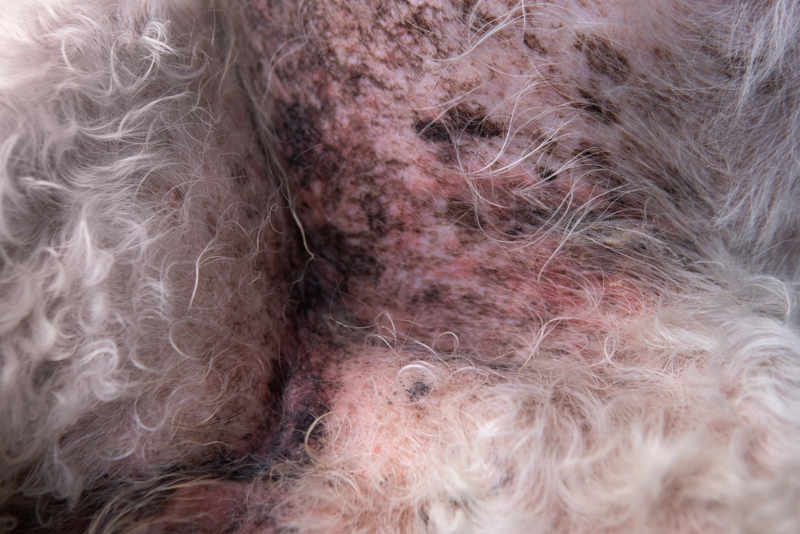
If your dog has chronic allergies, consult with your veterinarian. He may benefit from steroid treatment or a hypoallergenic diet.
4. Parasites
External parasites like fleas and mites can cause black scabs or spots on your dog. Fleas usually jump on your dog to feed and often leave behind flea dire (feces) that resemble tiny black scabs. Additionally, their bites can trigger an allergic reaction known as flea bite dermatitis that can leave black scabs.
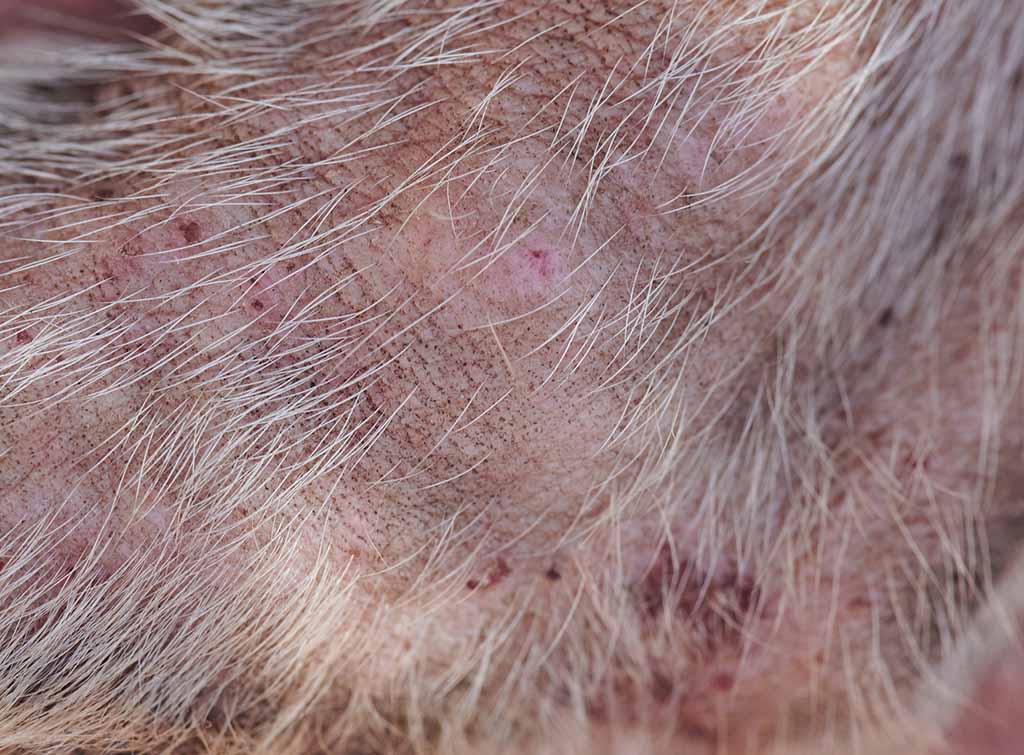
On the other hand, mites tend to burrow under your dogs skin, causing inflammation and irritation. As a result, your pup will scratch or chew the area continuously and cause skin trauma and scabbing.
To prevent skin issues from external parasites, keep your dog up-to-date on preventative treatments for parasites. If you suspect that your dog has mites or fleas, contact your veterinarian.
5. Skin infections
Skin infections in dogs are usually caused by Staphylococcus spp. bacteria or fungal infections(most commonly ringworm or yeast). These conditions irritate the skin and cause inflammation that can lead to scabbing or hyperpigmentation.
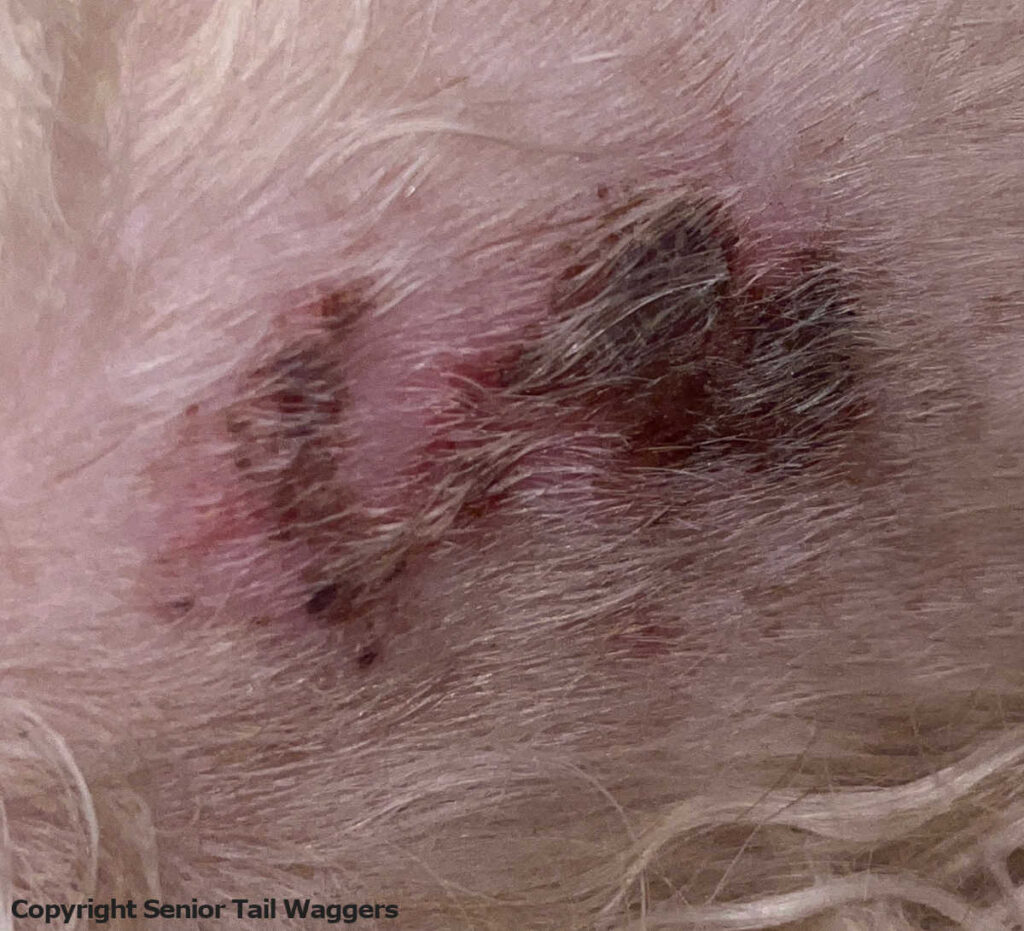
Skin infections should be examined by your veterinarian to properly diagnose the underlying cause and administer the appropriate treatments. Depending on the type and severity of the infection, your veterinarian may prescribe topical treatments, antifungal medication, or antibiotics.
Learn more about black spots on dog skin or black scabs on dogs (with more pictures and advice from our veterinarian team).
Learn more about lumps and bumps on dogs:
Dr. Liz (Elizabeth) Guise graduated from the University of Minnesota with a doctorate in Veterinary Medicine (DVM). She worked as a veterinarian for two years before working for the US Department of Agriculture for 13 years.
View all posts
Disclaimer: This website's content is not a substitute for veterinary care. Always consult with your veterinarian for healthcare decisions. Read More.

